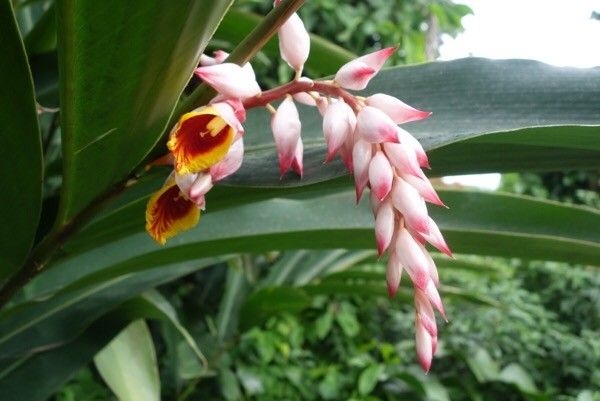Shell Ginger
(Alpinia zerumbet)
Shell Ginger (Alpinia zerumbet)
/
/

christiane Fazer
CC BY-SA 4.0
Image By:
christiane Fazer
Recorded By:
Copyright:
CC BY-SA 4.0
Copyright Notice:
Photo by: christiane Fazer | License Type: CC BY-SA 4.0 | License URL: https://creativecommons.org/licenses/by-sa/4.0/ | Attribution: christiane Fazer (cc-by-sa) | Rights Holder: christiane Fazer | Publisher: PlantNet | Date Created: 2018-07-19T22:00Z | Title: Alpinia zerumbet (Pers.) B.L.Burtt & R.M.Sm.: flower | Notes: |




































































Estimated Native Range
Summary
Alpinia zerumbet, commonly known as Shell Ginger, is an evergreen perennial herb originating from open woodlands and forest margins in East Asia, particularly Japan and China. It can reach heights of 8 to 10 ft (2.4 to 3.0 m) in tropical climates, forming dense, upright clumps. The plant is known for its striking, pendant inflorescences with funnel-formed flowers that bloom in late spring to early summer. The flowers are showy, with white or pink perianths and yellow labella marked with red spots and stripes, creating a shell-like appearance. Shell Ginger’s foliage is also ornamental, with broad, variegated leaves that add a tropical flair to the garden.
Shell Ginger is valued for its ornamental flowers and foliage, and it is often used in tropical and subtropical gardens as a specimen plant, in borders, or as a container plant in cooler climates. It thrives in rich, medium-wet to wet, well-drained soils and prefers full sun to part shade, with afternoon shade recommended in hot summer climates. Indoor cultivation requires bright light and high humidity. While it is generally easy to maintain, it can be invasive outside its native range, so gardeners should check local regulations before planting. It is also susceptible to root rot in poorly drained soils and may require protection from cold in temperate zones.CC BY-SA 4.0
Shell Ginger is valued for its ornamental flowers and foliage, and it is often used in tropical and subtropical gardens as a specimen plant, in borders, or as a container plant in cooler climates. It thrives in rich, medium-wet to wet, well-drained soils and prefers full sun to part shade, with afternoon shade recommended in hot summer climates. Indoor cultivation requires bright light and high humidity. While it is generally easy to maintain, it can be invasive outside its native range, so gardeners should check local regulations before planting. It is also susceptible to root rot in poorly drained soils and may require protection from cold in temperate zones.CC BY-SA 4.0
Plant Description
- Plant Type: Herb
- Height: 2-4 feet
- Width: 2-4 feet
- Growth Rate: Moderate
- Flower Color: Pink, White
- Flowering Season: Spring
- Leaf Retention: Evergreen
Growth Requirements
- Sun: Full Sun, Part Shade
- Water: Medium
- Drainage: Medium
Common Uses
Bee Garden, Bird Garden, Border Plant, Butterfly Garden, Fragrant, Groundcover, Hummingbird Garden
Natural Habitat
Open woodlands and forest margins in East Asia
Other Names
Common Names: Shellplant, Light Galangal, Shell-Ginger, Shellflower, Variegated Ginger, Butterfly Ginger, Pink Porcelain-Lily, Jättegalangarot, 月桃
Scientific Names: , Alpinia zerumbet, Alpinia speciosa, Languas speciosa, Languas schumanniana, Alpinia schumanniana, Catimbium speciosum, Costus zerumbet, Renealmia spectabilis, Alpinia cristata
GBIF Accepted Name: Alpinia zerumbet (Pers.) B.L.Burtt & R.M.Sm.